Have you ever visited Temple Square? Even though we walk by it every day, we were surprised by the rich heritage hidden in the buildings, statues, and landscaping. From a former Temple Square missionary, we got the inside scoop to the rich history behind the buildings and monuments most of us pass by without even noticing.
If you've never had a chance to visit, or even if you have, you probably don't know all of these 40 facts about Temple Square.
The Tabernacle
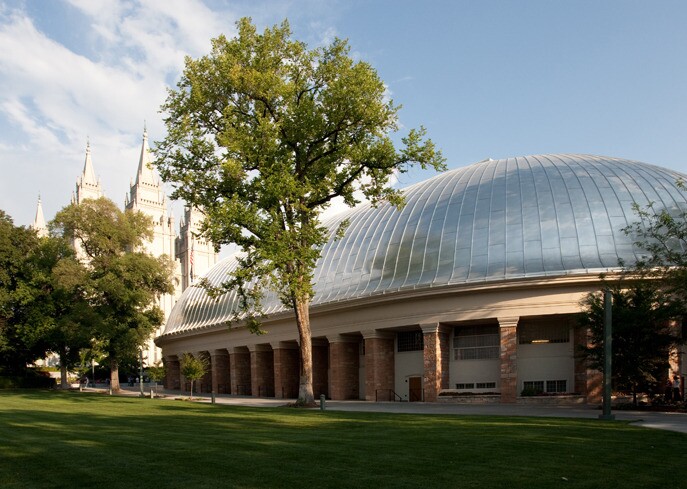
Photo from historyofmormonism.com.
1. The unique Tabernacle roof was designed and built by Henry Grow, a bridge builder. He was asked to span as broad an area as he could without using interior supports. He constructed the roof like a lattice bridge, which vertically distributes the very heavy weight of the roof and keeps the sandstone buttresses in alignment.
2. When first built, the Tabernacle was the largest hall in the world unsupported by columns.
3. The original roof was covered with 350,000 hand-hewn, white pine shingles. It was replaced with copper sheeting near the turn of the century, which was then replaced with aluminum in 1947.

Photo from ldsces.org
4. Before the gallery (the upper seating level) of the Tabernacle was built, the building echoed horribly, and it was hard for the congregation to understand the speakers. The gallery was built with acoustics in mind. A thirty-inch gap between the gallery and the wall gave the Tabernacle the amazing sound quality we all know today.
5. The Tabernacle could originally seat 10,000 people, but at the dedication it was packed to full capacity--around 13,000 people!
6. The benches were made from white pine, which was cheapest and easiest for the early Saints to build with, but they were all hand-painted to resemble oak, which was the preferred (but too-expensive) wood to use.
7. At the dedication of the Tabernacle, George Q. Cannon read the names of 105 people called to leave their homes to serve missions. Imagine having every new missionary called by name at General Conference! It would take weeks!
8. The Tabernacle was originally used as the main meeting area for Salt Lake City residents. Every Saint in the city was invited to go there for Sunday meetings, and speakers were told not to prepare a talk beforehand, but to just speak by the Holy Spirit's prompting.
9. Originally, the Sacrament passed during Tabernacle worship, but as the number of Saints grew, it took most of the two-hour meeting just to pass it around to everyone. This practice was eventually removed from Tabernacle meetings, with Saints encouraged to participate in the sacrament in their ward buildings instead.
The Tabernacle Organ
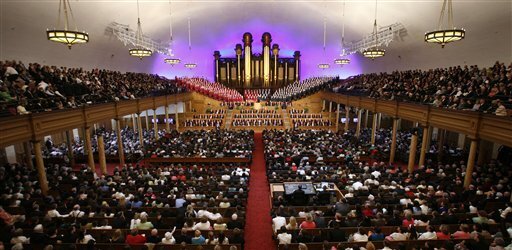
Photo from KSL.com
10. The organ was built by Joseph Ridges, an organ builder originally from England who moved to Australia and built the country’s first pipe organ there. The local presiding elder of the Church in Australia invited Ridges to send that organ to Utah, so he did, and moved to Utah himself. When Ridges arrived, Brigham Young was very appreciative of the state's first organ, and asked Ridges to build a much larger organ for the Tabernacle, which was about a year and a half from completion.
11. Of the 11,623 pipes that the organ has now, only 122 remain from the original Ridges organ.
12. The tallest pipes are 32 feet high. The smallest are only as wide as a pencil.
13. The ten largest pipes do actually play. They’re made of long, wedge-shaped strips of yellow pine glued together to form a hollow tube with about a one-inch-thick wall.
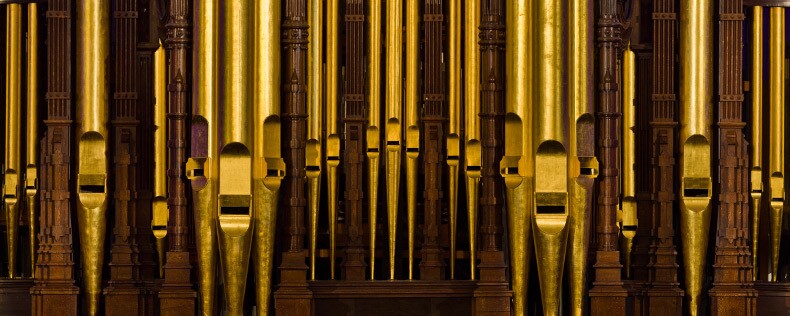
Photo from TabernacleChoir.org
14. When the Saints needed glue and calf skin to put the wood pipes together, firsthand accounts claim that an unusual number of cows and calves died of natural causes, providing what the people needed without necessitating a slaughter.
15. Back in the day, the organ was pumped by four strong men, until water from City Creek was used to power it.
The Handcart Pioneer Monument
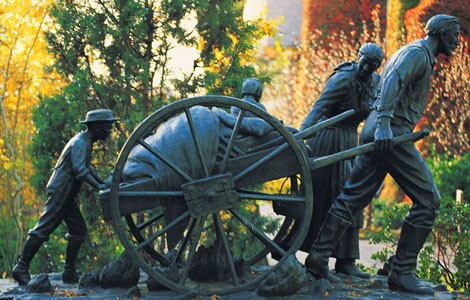
Photo from examiner.com
16. The monument to the handcart pioneers was built in 1942. Because of wartime priorities, special government approval had to be obtained to use so much bronze for a statue.
17. The statue was built and shipped from New York to Utah on its own railway flatcar, arriving in time for the Centennial celebration of the arrival of the first pioneers to enter the Salt Lake Valley.
18. The plants around the base of the monument are the same plants and shrubs that the pioneers would encounter--cactus, cedar, Manzanita, sage, and yucca.
The Great Salt Lake Base and Meridian
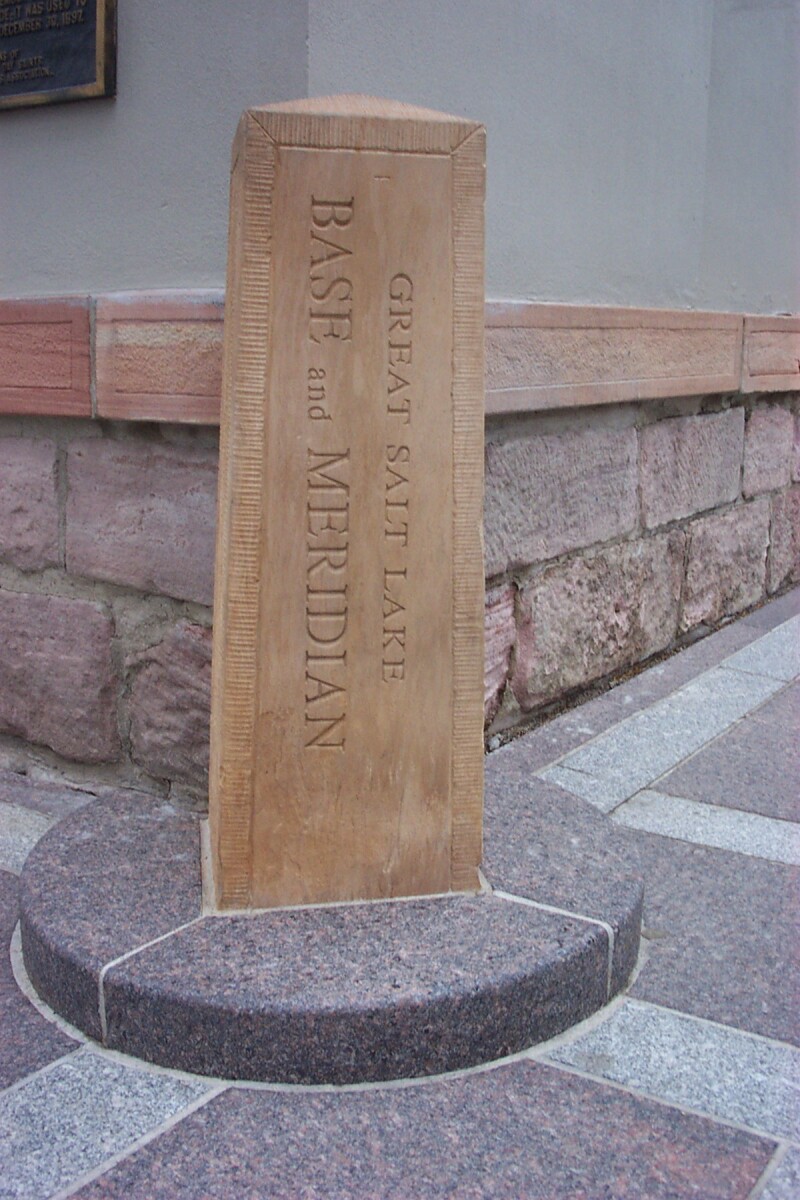
Photo from familysearch.org
18. On the southeast corner of Temple Square (outside wall, on the sidewalk), there is a sandstone marker that says “Great Salt Lake Base and Meridian”. Immediately behind the marker, on the wall, is a bronze plaque that lists the latitude, longitude, and altitude of that exact spot. Brigham Young declared this point the center of the city, and all streets were built and numbered around it, giving us the city street system we know today.
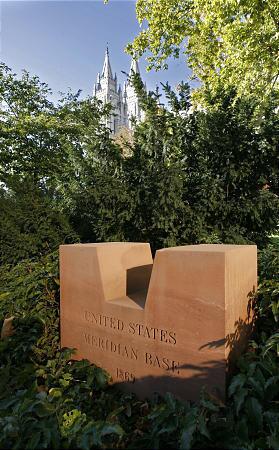
Photo from deseretnews.com
19. Inside Temple Square, near the southeast corner, there’s an oddly-shaped sandstone marker that says, “United States Meridian Base 1869”. This marker indicates the spot where United States officials set up an observatory to determine the Mountain Daylight Timezone, and thus establish standard time throughout the United States.
The Seagull Monument
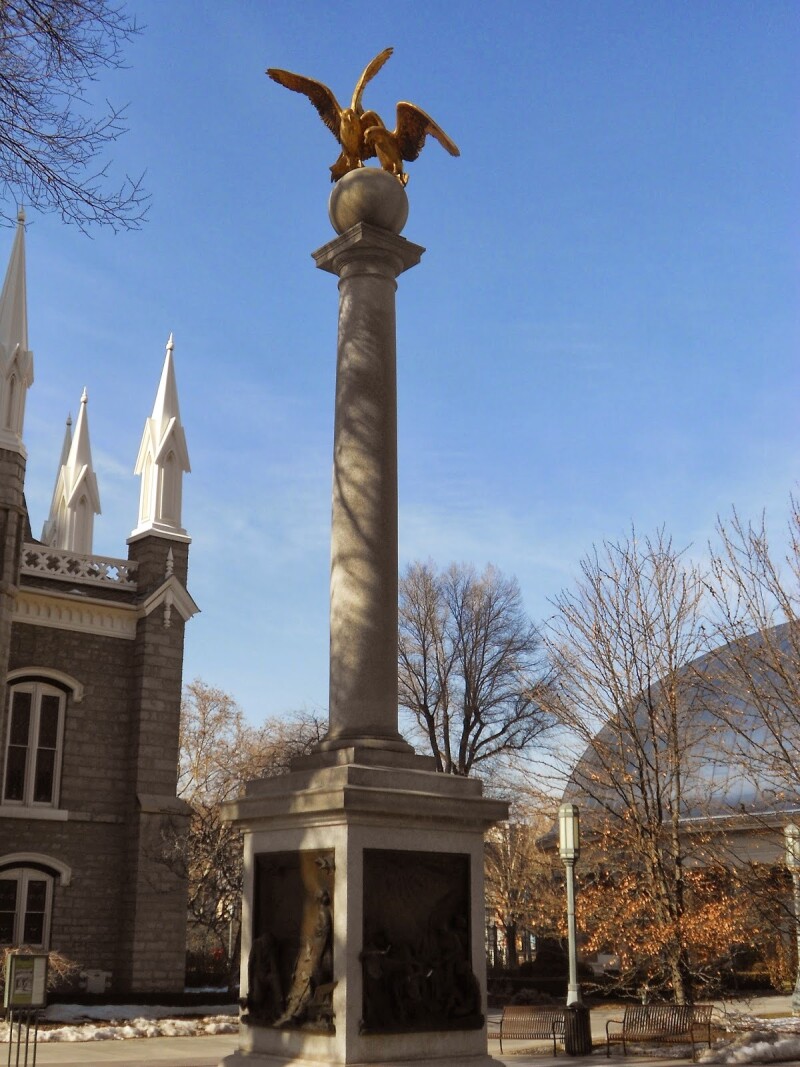
Photo from mysteryofutahhistory.blogspot.com
20. This monument to the seagulls that saved the early Saints from a plague of crickets was built specifically so that, when looking at it, you would see the seagulls against the blue sky. That's harder to do today with the large trees growing around it, but it's still meant to be viewed at that angle.
The Nauvoo Temple Bell
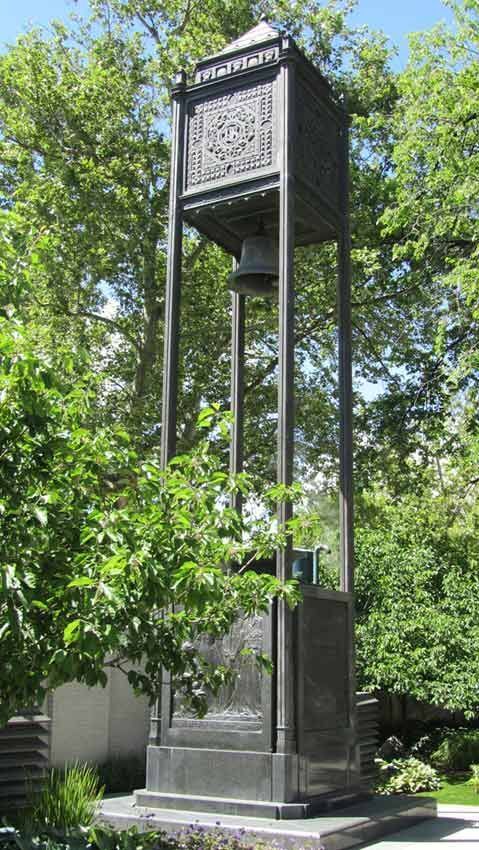
Photo from webs.schule.at
21. The Nauvoo Bell (originally hung in the Nauvoo temple) was brought by wagon train to the Salt Lake Valley after the Saints were forced out of Nauvoo. It was rung during the journey to signal daybreak and departure, and to warn hostile natives that night sentries were on duty.
22. The bell weighs 782 pounds and sounds a perfectly-pitched “C” note when struck. It's rung hourly on Temple Square, and is the bell heard on KSL broadcasts.
The Conference Center
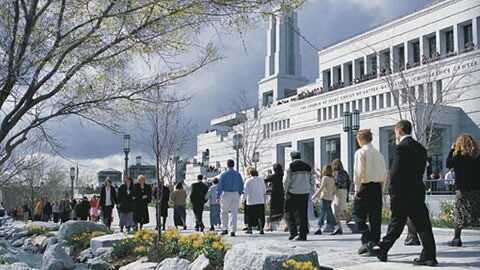
Photo from ChurchofJesusChrist.org
23. The Conference Center and grounds cover 10 acres of land--a full city block. The interior has 1.5 million square feet. Thanks to underground levels, all that space still fits under the city zoning's 75-foot height limit.
24. The main hall can seat 21,000 people, and the smaller adjacent theater seats 900. Imagine how many people could fit inside if all the standing room in the entire building was packed full!
25. During General Conference, 100 language translations are provided simultaneously from 60 translation booths. This system is second only to the United Nations.
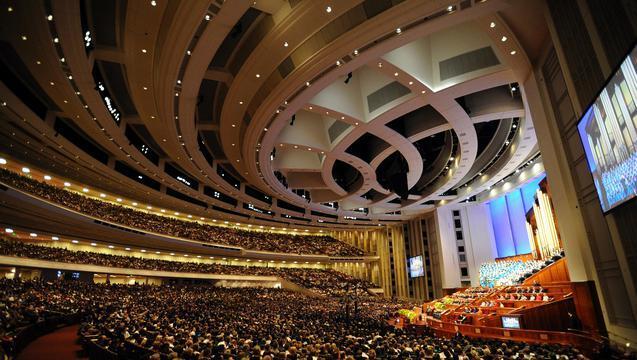
Photo from newsroom.org
26. All the paintings in the Conference Center are originals, as are many of the statues.
27. Every piece of the stage is movable, allowing it to be converted for stage productions and concerts. President Hinckley intended the Conference Center to be used for all sorts of uplifting productions, not just for General Conference.
28. The Conference Center's rooftop, with its gardens, fountains, and meadows, fulfills a prophetic statement by Brigham Young, who said in 1853 that he envisioned a downtown building with groves and ponds on the top.
The Salt Lake Temple
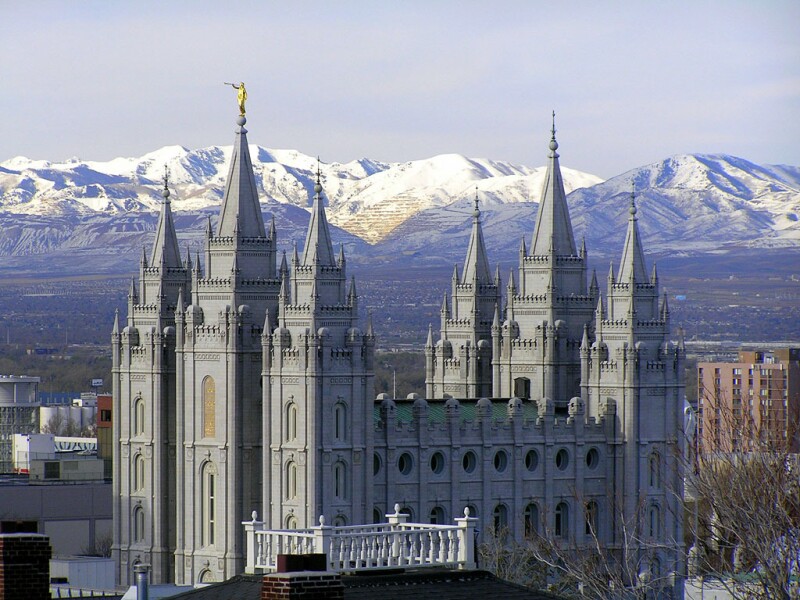
Photo from churchtemples.com
29. The walls of the Salt Lake temple are nine feet thick at the base and six feet thick at the top.
30. The Angel Moroni was built in Salem, Ohio.
31. The Angel stands 14 feet tall, with a steel rod extending down into the tower about 27 feet, where a 4,000 pound counterbalance keeps the statue standing strong against even the worst storms.
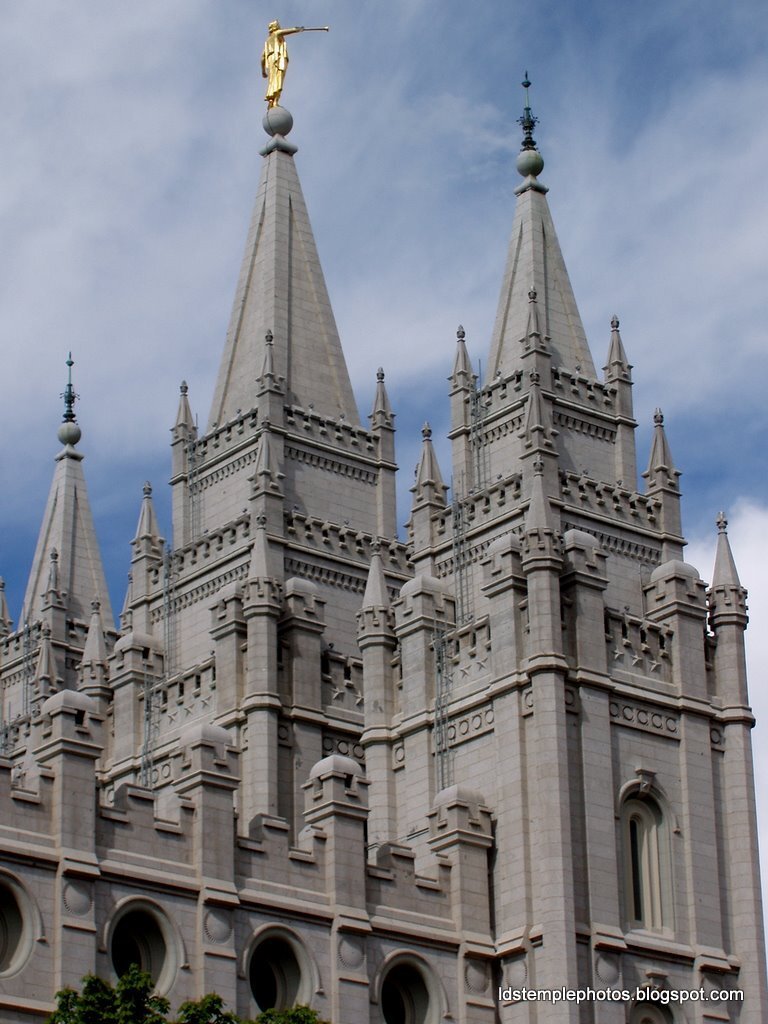
Photo from ldstemplephotos.blogspot.com
32. There is so much symbolism in the architecture of the temple that it would be impossible to cover it all here. But one thing most people don’t notice is the symbolism of the squares with circles above the roof line of the temple. The circle is symbolic of endless eternal life and perfection, while the square represents the earth and earth life. Combined, they symbolize man’s progression from mortal imperfection towards immortal perfection.
The Monument to the Three Witnesses to the Book of Mormon
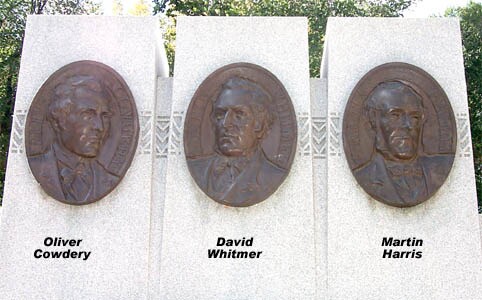
Photo from wikipedia.org
33. The monument to the Three Witnesses was designed by Harold W. Burton, who later served as Church Architect and was lead designer of the Hawaii Temple and the Cardston, Alberta temple.
The Memorial Statues of Joseph and Hyrum Smith
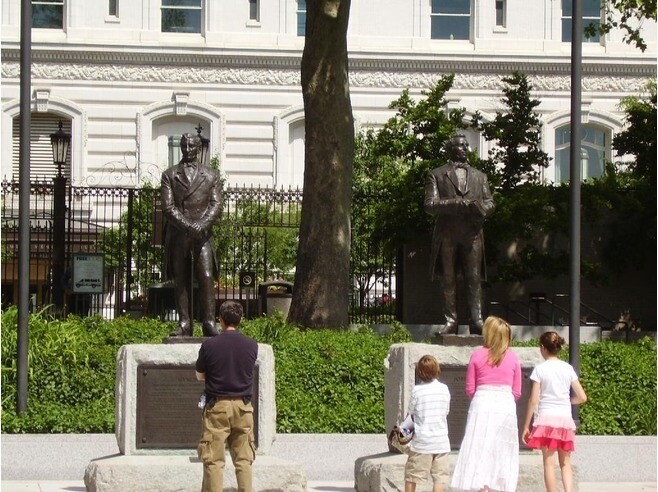
Photo from virtualtourist.com
34. These statues were originally designed to fit into the “sculpture niches” beside the two doors on the east side of the Temple. The sculpture niches are there because in Biblical times the entrances to the Jerusalem Temple were carefully guarded by the priests. For a number of years, those niches held the statues of Joseph and Hyrum Smith, but they were removed and placed in the Joseph Smith Memorial Gardens on June 27, 1911.
The Assembly Hall
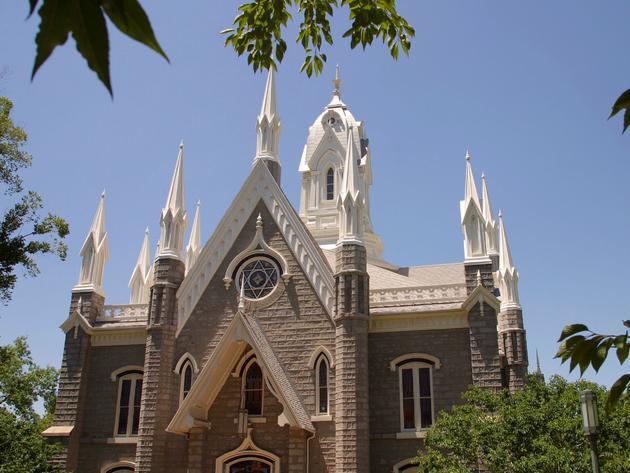
Photo from cdn.frontdoor.com
35. The site of the Assembly Hall was used as a gathering place for the Saints very soon after they arrived in the valley. Sagebrush was cleared away, and a crude building was erected and covered with leafy boughs to provide shade from the sun, providing the pioneers their first official meeting place.
36. The Saints couldn’t afford marble for the pillars of the Assembly Hall, so the columns are actually just made of wood and painted to look like marble.
37. The building used to have a mural on the ceiling with important figures and locations in the Church depicted. It also had clear windows, but they were replaced in 1891 by 36 stained-glass windows.
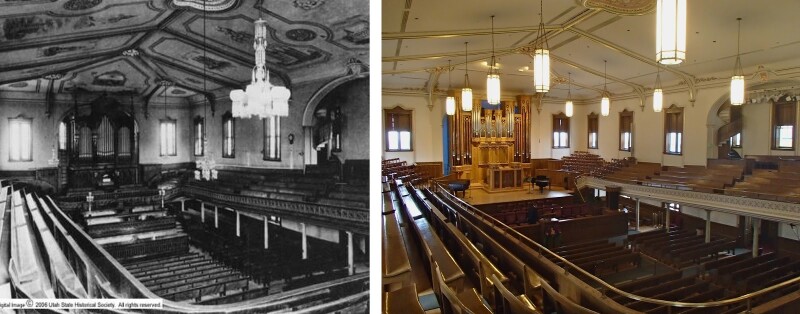
Photo from heritage.utah.gov
38. The Assembly Hall exterior was built with small, irregular stones discarded during the construction of the Salt Lake Temple. This meant that the original walls were rough and craggy. Workmen filled the surfaces with matching mortar to smooth out the appearance, and then regular mortar seams were added to give the illusion of large, uniform, granite blocks rather than “chippings.”
39. The two random flat-topped spires of the Assembly Hall were originally functioning chimneys, but were capped when the fireplaces were replaced with electric heating.
General
40. Temple Square attracts 3 to 5 million people every year, which is almost as much as the tourism Utah's five National Parks attract combined.
